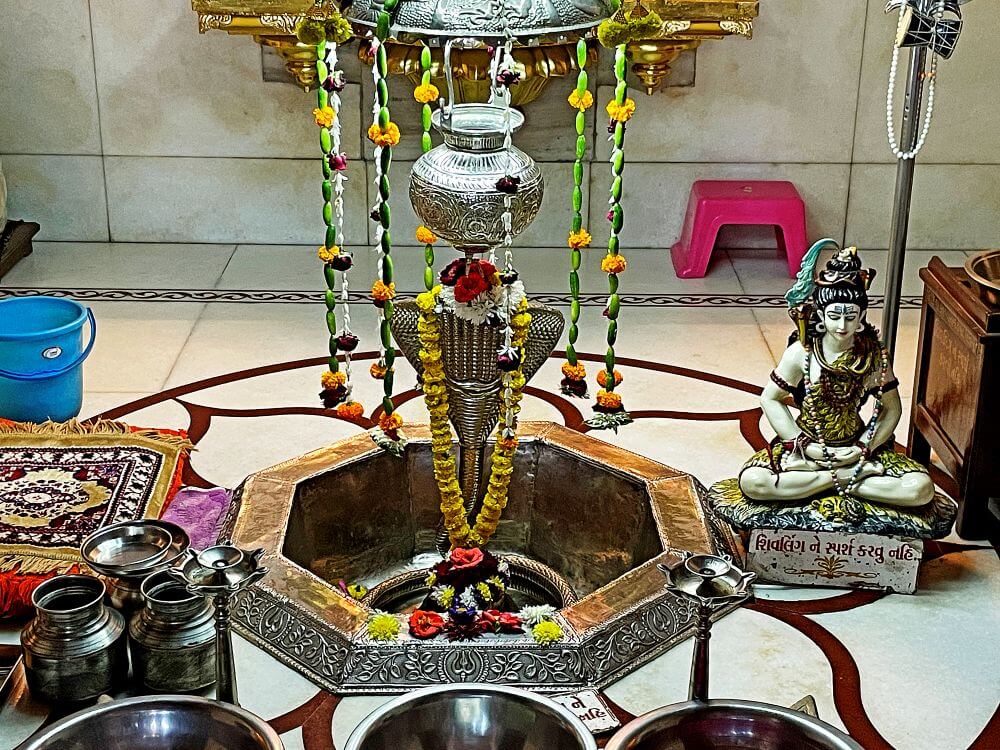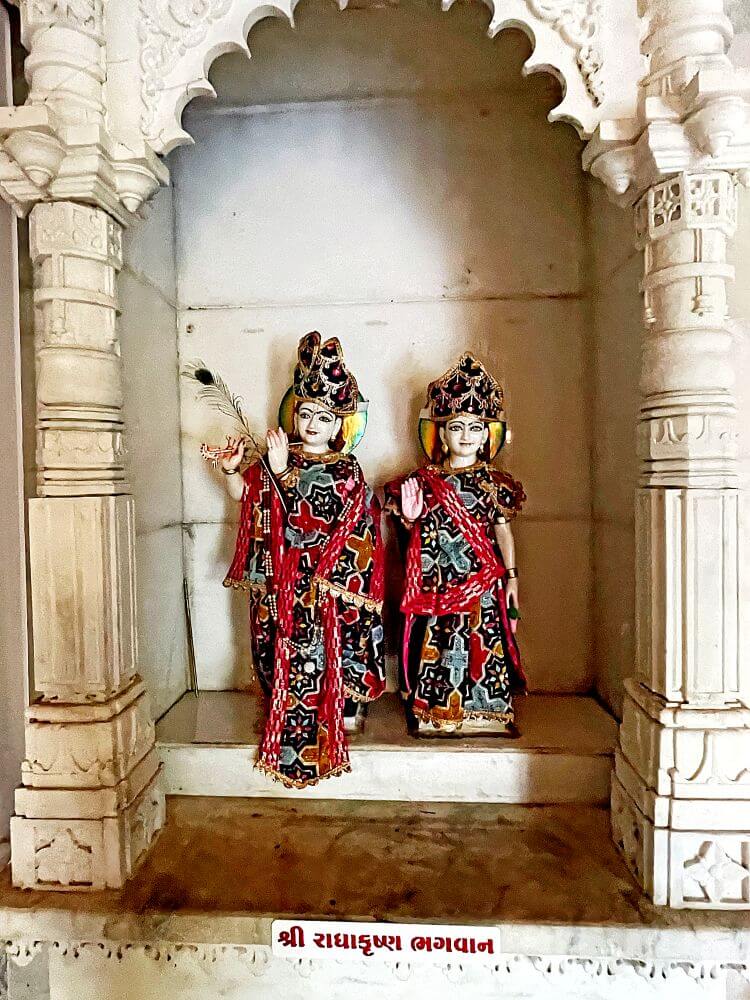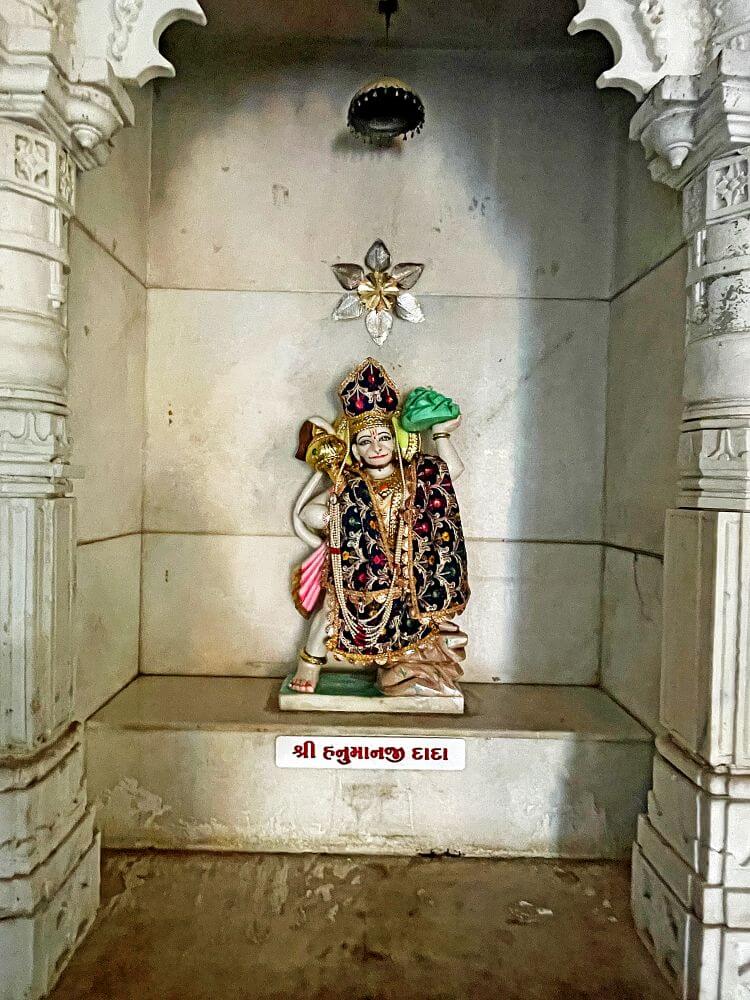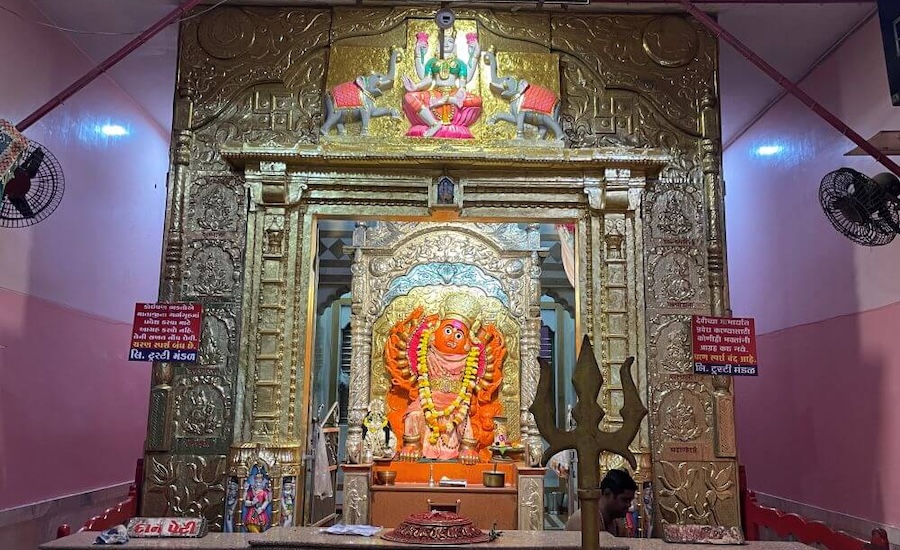
 Rundhnath Mahadev Temple, one of the ancient Shiva temples in Surat, is situated along the banks of the Tapi River. While the exact history of the temple remains obscure, it is believed to be over 400 years old. The Tapi Purana also references this sacred site. The temple houses a self-manifested (Swayambhu) Shivalinga, resembling the shape of a single-faced Rudraksha. Devotees hold a deep belief in its divine energy and consider it as significant as the twelve Jyotirlingas. This belief draws hundreds of visitors to the temple daily.
Rundhnath Mahadev Temple, one of the ancient Shiva temples in Surat, is situated along the banks of the Tapi River. While the exact history of the temple remains obscure, it is believed to be over 400 years old. The Tapi Purana also references this sacred site. The temple houses a self-manifested (Swayambhu) Shivalinga, resembling the shape of a single-faced Rudraksha. Devotees hold a deep belief in its divine energy and consider it as significant as the twelve Jyotirlingas. This belief draws hundreds of visitors to the temple daily.
In Hindu mythology, the Rudraksha symbolises the eye (Aksha) of Rudra (Shiva). According to legend, after intense penance, when Shiva opened his eyes, the tears that fell from them gave rise to Rudraksha beads. The Shivalinga at this temple, shaped like a Rudraksha, inspired its name, RundhnathMahadev Temple. The area of Magdalla village,  where the temple is located, is also named after this revered deity.
where the temple is located, is also named after this revered deity.
Originally, the temple was modest in size. It is said that around 400 years ago, it underwent its first major renovation. Recently, the temple was refurbished once again, giving it its present grandeur. Devotees revere the temple as a powerful site of worship, imbued with spiritual significance.
An intriguing legend surrounds the Rundhnath Mahadev Temple, tracing its connection to a devout Shiva worshipper named Popat Bharati Goswami from Saurashtra. About 150 years ago, it is believed that Lord Shiva appeared in Popat Bharati’s dream, instructing him to come and serve at this temple. Unaware of the temple’s exact location, Popat Bharati shared his vision with his uncle. During their discussion, a resident of Magdalla overheard them and provided details about the temple. Following this, Popat Bharati accompanied the local man to the temple. Since then, the Goswami family has been dedicated to performing rituals and serving at this sacred site.
The temple is situated within a sprawling complex along Dumas Road. Upon entering the premises, a small shrine dedicated to Sankatmochan Hanuman greets visitors on the left. Directly across from it, on a raised platform, is a black stone slab representing Shani.  Adjacent to these is the Rinmukteshwar Mahadev Temple, believed to help devotees overcome their debts and burdens.
Adjacent to these is the Rinmukteshwar Mahadev Temple, believed to help devotees overcome their debts and burdens.
The main temple’s structure includes an open assembly hall (Sabhamandap), an inner sanctum (Antaral), the sanctum sanctorum (Garbhagriha) and a circumambulatory path (Pradakshina Marg) around the inner sanctum. In the Sabhamandap, a golden Shri Yantra is placed on a flat stone platform in front of a statue of Nandi, Shiva’s sacred bull. The entrance to the Antaral is flanked by statues of divine gatekeepers (Dwarpalas), while niches on either side house idols of Ganesha and Hanuman. The Garbhagriha enshrines the Shivalinga, alongside the Samadhi (final resting place) of Popat Bharati Goswami, marking his enduring connection to the temple.
In front of the main temple is a Yajna (sacrificial fire) hall, which is used for special rituals and ceremonies. Nearby, beneath a sacred Peepal tree, stands a small shrine containing idols of Vishnu and Shaligram (sacred black stones associated with Lord Vishnu).
The Rundhnath Mahadev Temple boasts an architectural style that merges grandeur with intricate artistry. The temple is primarily constructed with red sandstone and marble, which lends a timeless elegance to its structure.  Its layout comprises a Mukhamandapa (porch), a Sabhamandapa (assembly hall), a smaller intermediate chamber (Antaral) and the sanctum sanctorum (Garbhagriha). Flanking the Sabhamandapa are expansive verandas on both sides. These verandas, along with the Mukhamandapa, feature pyramid-shaped subsidiary spires (Upa-shikharas), while the Sabhamandapa is crowned with a domed spire. The Garbhagriha has a unique Uru-Shringa style spire, characterised by smaller replicas of the main spire cascading down its surface. At the pinnacle of the spire is a sculpted Amlaka (a disc-shaped ornament) and a golden Kalash (finial).
Its layout comprises a Mukhamandapa (porch), a Sabhamandapa (assembly hall), a smaller intermediate chamber (Antaral) and the sanctum sanctorum (Garbhagriha). Flanking the Sabhamandapa are expansive verandas on both sides. These verandas, along with the Mukhamandapa, feature pyramid-shaped subsidiary spires (Upa-shikharas), while the Sabhamandapa is crowned with a domed spire. The Garbhagriha has a unique Uru-Shringa style spire, characterised by smaller replicas of the main spire cascading down its surface. At the pinnacle of the spire is a sculpted Amlaka (a disc-shaped ornament) and a golden Kalash (finial).
The temple offers multiple entry points, including those through the Mukhamandapa and the verandas. The pillars and ceilings of the Mukhamandapa feature exquisite carvings of floral and geometric patterns, showcasing the mastery of traditional craftsmanship. Above the doorway leading to the Sabhamandapa, a panel (Lalat Bimba) depicts a sculpted image of Shiva and Parvati, flanked by statues of Nandi and a lion. Crowning this panel is an intricately carved Makara Torana (a decorative arch featuring mythical aquatic creatures).
The spacious Sabhamandapa, paved with marble tiles, is adorned with ornately carved pillars and a domed ceiling.  The dome is particularly captivating, featuring relief sculptures of river goddesses such as Ganga, Sindhu, Tapi, Narmada and Kaveri. Along the walls of the Sabhamandapa, decorative niches (Devakosha) house finely crafted marble statues of deities, including Ganesha, Hanuman, Ashtabhuja Ambika (the eight-armed goddess), Dattatreya, Adi Shankaracharya, Sai Baba, Jalaram Bapa and Radha-Krishna.
The dome is particularly captivating, featuring relief sculptures of river goddesses such as Ganga, Sindhu, Tapi, Narmada and Kaveri. Along the walls of the Sabhamandapa, decorative niches (Devakosha) house finely crafted marble statues of deities, including Ganesha, Hanuman, Ashtabhuja Ambika (the eight-armed goddess), Dattatreya, Adi Shankaracharya, Sai Baba, Jalaram Bapa and Radha-Krishna.
At the forefront of the Garbhagriha stands a large, intricately sculpted statue of Nandi, Shiva’s sacred bull, crafted from black stone and placed on a raised platform. The sanctum’s intermediate chamber (Antaral) features niches housing marble idols of Sheetala Mata and Annapurna Mata, revered goddesses of health and nourishment.
The sanctum sanctorum (Garbhagriha) of Rundhnath Mahadev Temple is adorned with a meticulously carved stone doorframe. On one side of the frame stands a sculpture of a Vaishnava doorkeeper (Dwarpal), while on the other side is a statue of a female attendant holding a conch shell and a fly-whisk (Chauri). At the centre of the sanctum, the self-manifested (Swayambhu) Shivalinga rests in an octagonal, silver-plated, recessed space. A beautifully  crafted silver serpent (Nag) coils above the Shivalinga, forming a canopy. Suspended above the ling is a delicately engraved silver vessel (Galantika), used for ritualistic ablutions.
crafted silver serpent (Nag) coils above the Shivalinga, forming a canopy. Suspended above the ling is a delicately engraved silver vessel (Galantika), used for ritualistic ablutions.
Adjacent to the Shivalinga is a serene marble statue of Lord Shiva in a meditative posture. Nearby, a pedestal holds the ceremonial silver mask of Lord Shiva, which is placed over the Shivalinga during festive occasions. The rear wall of the sanctum houses a niche (Devakosha) featuring a statue of Goddess Parvati. On one side of the sanctum lies a small shrine dedicated to Lakshmi Narayan and Narayani Mata, while on the other side, a golden-embellished canopy (Makhar) shelters a Ram Darbar ensemble with idols of Lord Rama, Lakshman and Sita.
The temple is open for devotees from 6 AM to 12 PM and again from 3 PM to 9 PM daily. Two Aartis (prayer ceremonies) are conducted daily, at 7 AM and 7 PM, accompanied by a devotional Manas Puja, where devotees participate in offering their prayers. Worshippers believe that sincere devotion to the self-manifested Shivalinga alleviates life’s challenges and ensures the fulfilment of long-pending tasks. This unwavering faith draws nearly 700 devotees daily to seek blessings at the temple.
The temple becomes a hub of activity during Mahashivaratri, with thousands of devotees thronging the premises. On this auspicious day, elaborate rituals such as Laghu Rudra, Abhisheka (ritual bathing of the Shivalinga), Havan (fire offerings) and special pujas are performed. Similarly, during the Shravan month, the temple witnesses an influx of thousands of devotees. A unique tradition during this time involves creating a Shivalinga entirely out of Rudraksha beads, inspired by the practices at Ujjain’s famous Mahakal Temple.



